
God creates Adam – Painting in Sistine Chapel
The Ceiling: The painting of the ceiling took four years. It took its toll on Michelangelo’s health: working on his back, an impressive amount of paint must have entered his lungs. But it was certainly worth the effort.
After finishing the work in 1512, Michelangelo switched to making sculptures, hardly painting anything until 1536, when he started on the Last Judgment.
The central part of the ceiling shows scenes from Genesis. On both sides are several Biblical prophets and some sibyls: female prophets from ancient times, who, according to the Church, had predicted the coming of Jesus. Among the prophets are all the major ones: Isaiah, Ezekiel, Jeremiah and Daniel. In the lunettes above the windows a number of Jesus’ ancestors are shown, Boaz being one of them. It is unclear who the figures in the triangular parts above the lunettes represent. The corners of the ceiling show the rescuing of the Israelites, which was seen as a prelude to the Salvation.
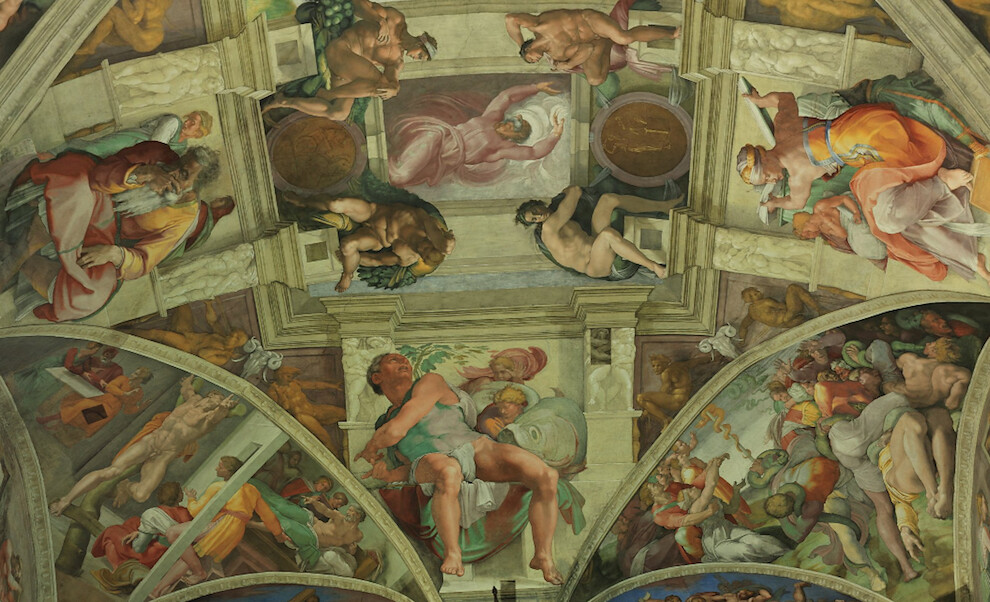
Sistine Chapel Ceiling – Top of image: Separation of Light from Darkness.
Bottom: Jonah.
Top left: Jermiah;
Top right: Libyan Sibyl.
Bottom right corner: Moses raises up the bronz serpant.
Bottom left corner: Haman is denounced and slain. – These corner and ceiling paintings were completed sometime in 1511, when Michelangelo Buonarroti was 59 years old.
Bottom: Jonah.
Top left: Jermiah;
Top right: Libyan Sibyl.
Bottom right corner: Moses raises up the bronz serpant.
Bottom left corner: Haman is denounced and slain. – These corner and ceiling paintings were completed sometime in 1511, when Michelangelo Buonarroti was 59 years old.
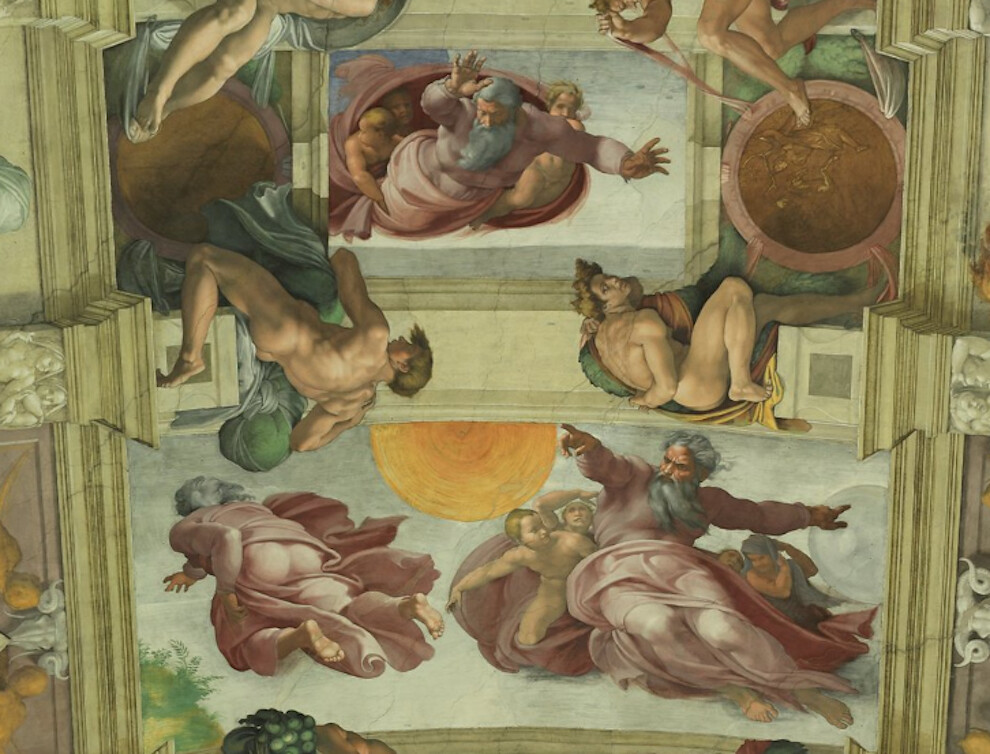
Sistine Chapel Ceiling: Top of image: Separation of the Earth from the Waters.
Bottom of image: Creation of the Sun, Moon, and Planets. Both finished 1511.
Bottom of image: Creation of the Sun, Moon, and Planets. Both finished 1511.
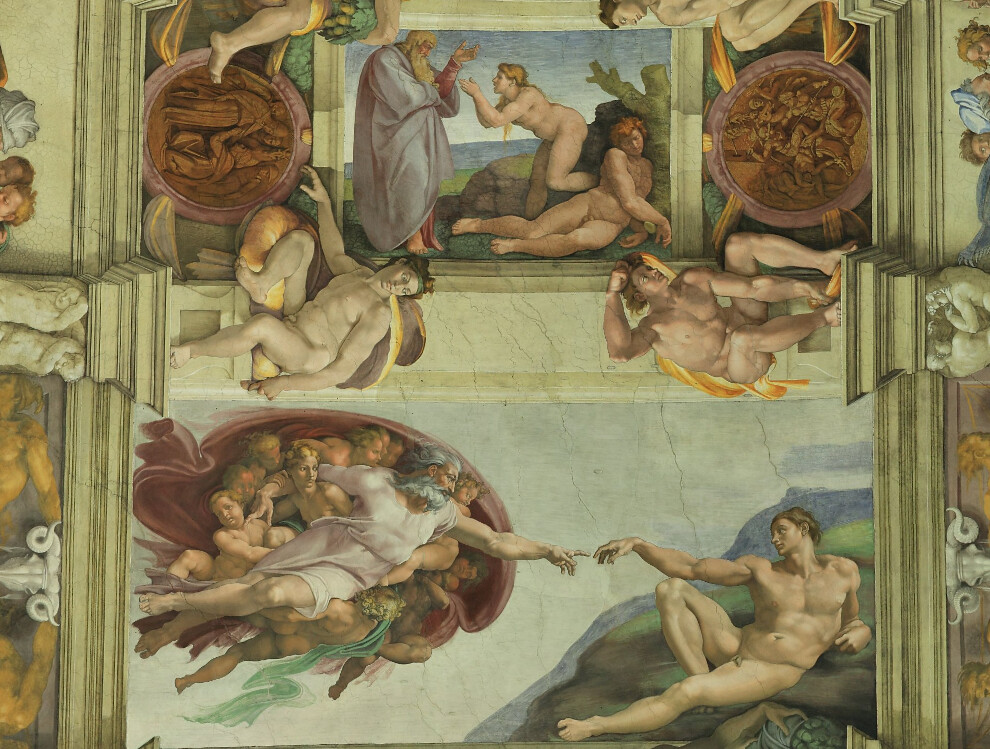
Sistine Chapel Ceiling: Top of image: Creation of Eve, dated 1509, when Michelangelo was 57 years old.
Bottom of image: Creation of Adam – The Centerpiece of the ceiling,
Bottom of image: Creation of Adam – The Centerpiece of the ceiling,
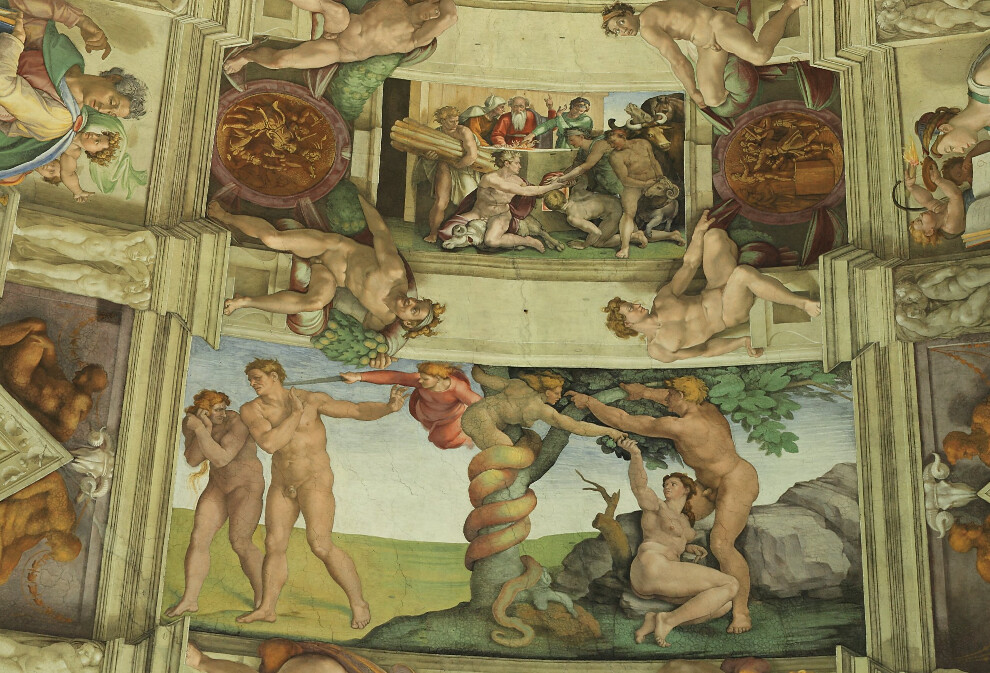
Top of image: Noah and his family make a sacrifice to God on their safe delivery from the great flood.
Bottom of image: The Fall and Expulsion from Garden of Eden”, dated 1509.
Bottom of image: The Fall and Expulsion from Garden of Eden”, dated 1509.
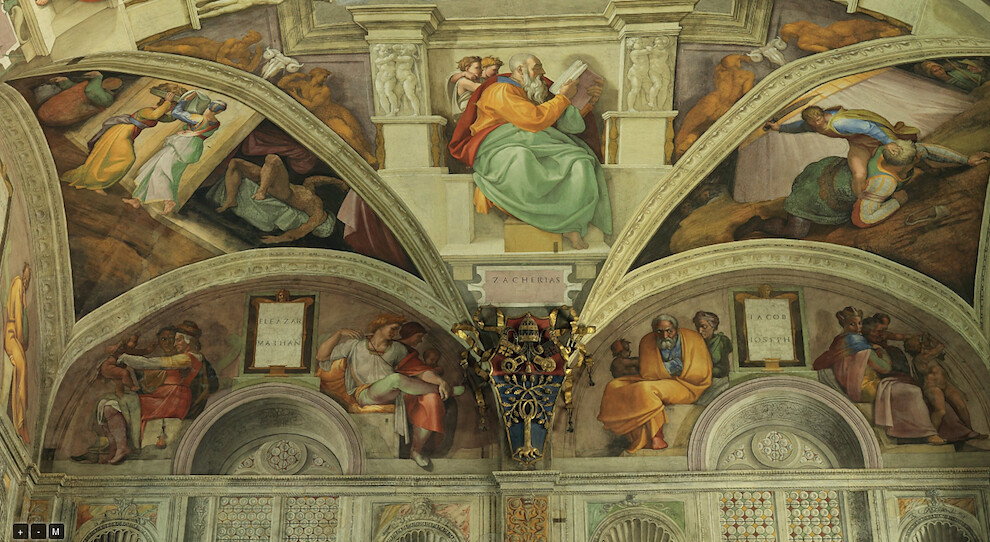
Sistine Chapel Ceiling – Top center: Zaheriah.
Top left: Judith slays Holofernes.
Top right: David Slays Goliath.
Bottom right: Jacob and Joseph.
Bottom left: Eleaza and Mathan.
Top left: Judith slays Holofernes.
Top right: David Slays Goliath.
Bottom right: Jacob and Joseph.
Bottom left: Eleaza and Mathan.
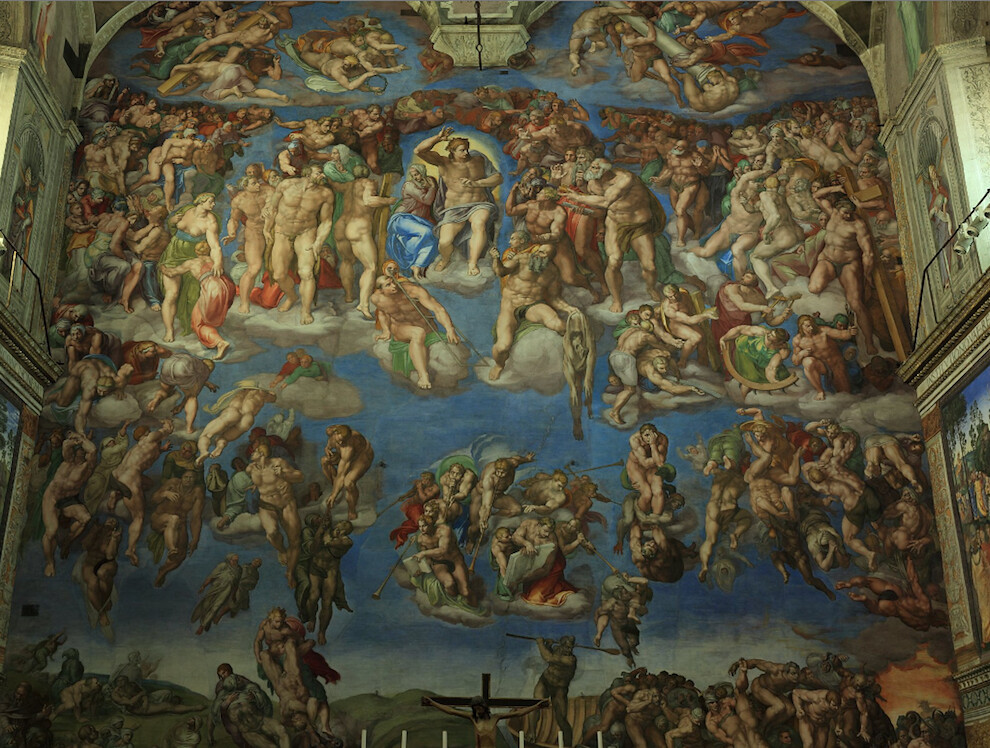
Cistine Chapel rear wall – The Last Judgment (Michelangelo Buonarroti – dated 1539, when Michelangelo was 87 years of age).
The angels in the middle blow their horns to raise the dead. One of them holds the Book in which all has been written down and upon which Jesus will base his judgment.
To the left, the chosen are escorted to Heaven by angels. To the right, the damned are going to Hell. Michelangelo was inspired by Dante’s Inferno. Charon (with oar) and his devils are leading the damned to judge Minos (with snake).
Jesus is seated in the middle with his mother Mary at his side. The two large figures are Paul (left) and Peter (right, with keys in hand). The figure underneath and to the right of Jesus is St. Bartholomew – a self-portrait by Michelangelo. In his hand, his mortal skin.
Above in the lunettes are symbols of the Passion – the cross, the crown of thorns, the pillar of flagellation, the spear, and the sponge dipped in vinegar.
The angels in the middle blow their horns to raise the dead. One of them holds the Book in which all has been written down and upon which Jesus will base his judgment.
To the left, the chosen are escorted to Heaven by angels. To the right, the damned are going to Hell. Michelangelo was inspired by Dante’s Inferno. Charon (with oar) and his devils are leading the damned to judge Minos (with snake).
Jesus is seated in the middle with his mother Mary at his side. The two large figures are Paul (left) and Peter (right, with keys in hand). The figure underneath and to the right of Jesus is St. Bartholomew – a self-portrait by Michelangelo. In his hand, his mortal skin.
Above in the lunettes are symbols of the Passion – the cross, the crown of thorns, the pillar of flagellation, the spear, and the sponge dipped in vinegar.
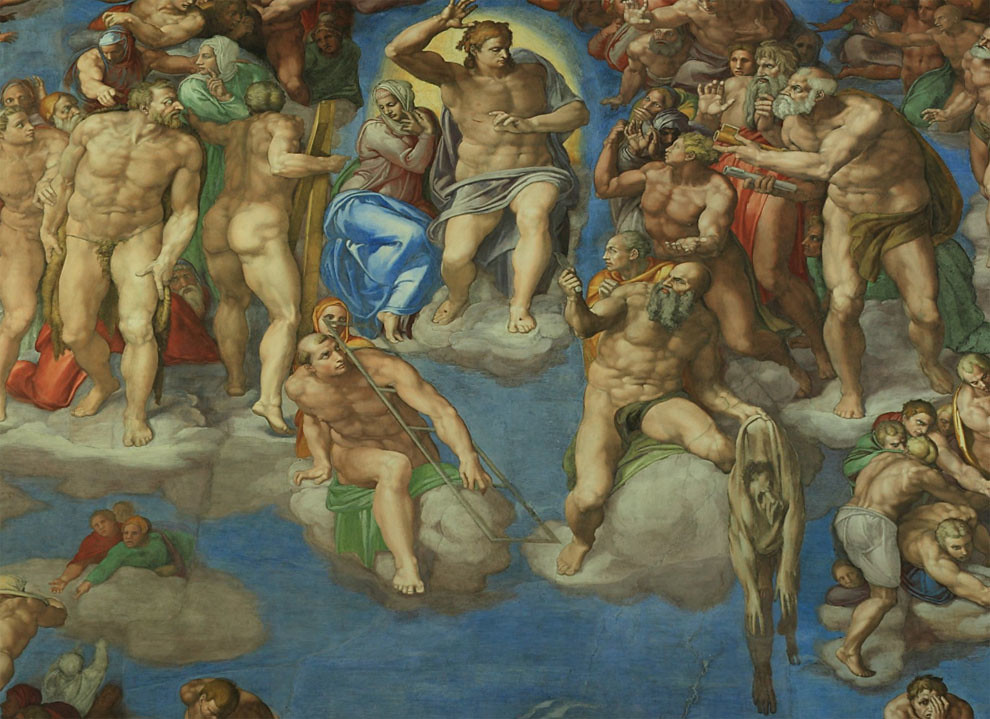
Sistine Chapel – Center of The Last Judgement. The center figure is Christ deciding the destiny of the human race. With a gesture of his arms he damns a large part of humanity plunging them into hell, but some are saved rising to heaven. Even the Madonna at his side seems to cower in fear at the scene.
Below right: St Bartholomew holds a sheet of his own skin in his left hand and in his right hand is a knife. This symbolizes the terrible fate of Bartholomew who was flayed alive. The face of the skin is Michelangelo’s.
Below left: St Lawrence holding a ladder (this symbolizes the saint’s martyrdom on a grate over hot coals).
Below right: St Bartholomew holds a sheet of his own skin in his left hand and in his right hand is a knife. This symbolizes the terrible fate of Bartholomew who was flayed alive. The face of the skin is Michelangelo’s.
Below left: St Lawrence holding a ladder (this symbolizes the saint’s martyrdom on a grate over hot coals).

Sistine Chapel ceiling – northern wall, Prophets and Sibyls: from left to right: the Libyan Sibyl, Daniel, the Sibyl from Cumae, Isaiah, and the Delphic Sibyl.

Sistine Chapel ceiling – southern wall, Prophets and Sibyls: from left to right: Joel, the Erythrean Sibyl, Ezekiel, the Persian Sibyl, Jeremiah.

Sistine Chapel Northern Wall- The Baptism of Jesus (Pietro Perugino, 1482)
In the middle teh Baptism of Jesus
To the right, John the Baptist is seen preaching.
On the top left, circumcision of Moses’ son.
In the middle teh Baptism of Jesus
To the right, John the Baptist is seen preaching.
On the top left, circumcision of Moses’ son.
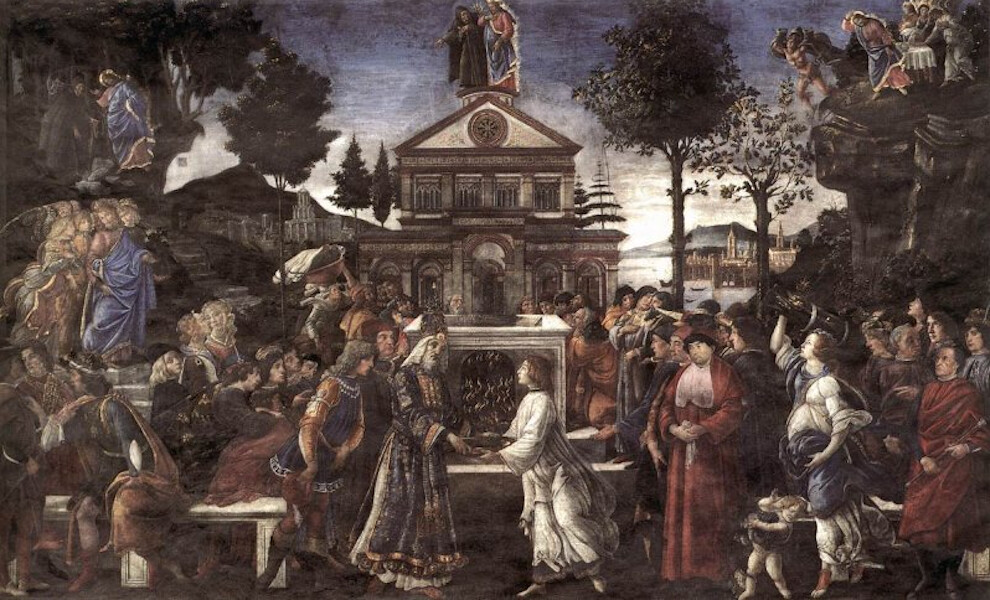
Sistine Chapel Northern Wall- The temptation of Jesus (Botticelli (Sandro Filipepi) 1481-1482)
Top left: After his baptism Jesus spends 40 days in the wilderness, fasting. The devil asks him to turn stone into bread, thereby proving that he is the son of God. Jesus refuses: But he answered and said: It is written: ‘Man shall not live on bread alone, but on every word that proceeds out of the mouth of God.’
In the top center the devil and Jesus stand on the roof of a temple. The devil challenges Jesus to let himself fall: surely he will be caught by angels.
On the right the two are on a high cliff. The devil offers Jesus all kingdoms in the world.
The main part of the fresco shows an offering. It probably is the sacrifice the leper offered after he was healed by Jesus (Matthew 8:3).
Top left: After his baptism Jesus spends 40 days in the wilderness, fasting. The devil asks him to turn stone into bread, thereby proving that he is the son of God. Jesus refuses: But he answered and said: It is written: ‘Man shall not live on bread alone, but on every word that proceeds out of the mouth of God.’
In the top center the devil and Jesus stand on the roof of a temple. The devil challenges Jesus to let himself fall: surely he will be caught by angels.
On the right the two are on a high cliff. The devil offers Jesus all kingdoms in the world.
The main part of the fresco shows an offering. It probably is the sacrifice the leper offered after he was healed by Jesus (Matthew 8:3).
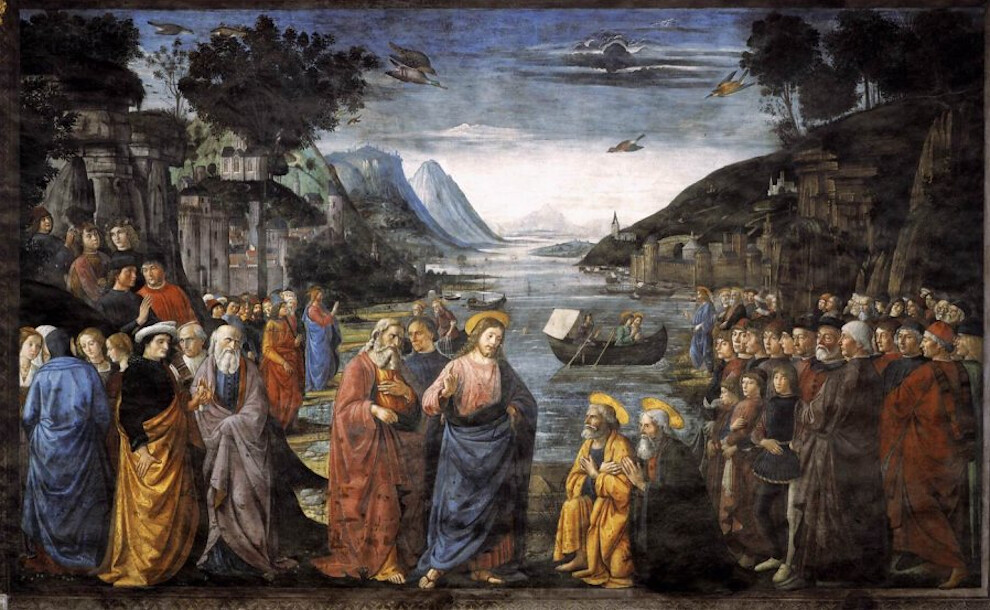
Sistine Chapel Northern Wall-Calling of the first disciples (Domenico Ghirlandaio, 1481-1482).
The calling of Peter and Andrew, the Jesus’ first followers, is shown in two scenes.
In the background on the left, Jesus calls them while they are setting out a net in the Sea of Galilee, as described in the Bible.
The calling is repeated in the foreground, this time before a large audience.
In the background on the right, Peter and Andrew stand behind Jesus as he calls two other fishermen. They are the brothers James and John, who are fishing with their father.
The figures in the foreground on the right are important citizens of Florence: bankers, traders and scientists.
The calling of Peter and Andrew, the Jesus’ first followers, is shown in two scenes.
In the background on the left, Jesus calls them while they are setting out a net in the Sea of Galilee, as described in the Bible.
The calling is repeated in the foreground, this time before a large audience.
In the background on the right, Peter and Andrew stand behind Jesus as he calls two other fishermen. They are the brothers James and John, who are fishing with their father.
The figures in the foreground on the right are important citizens of Florence: bankers, traders and scientists.
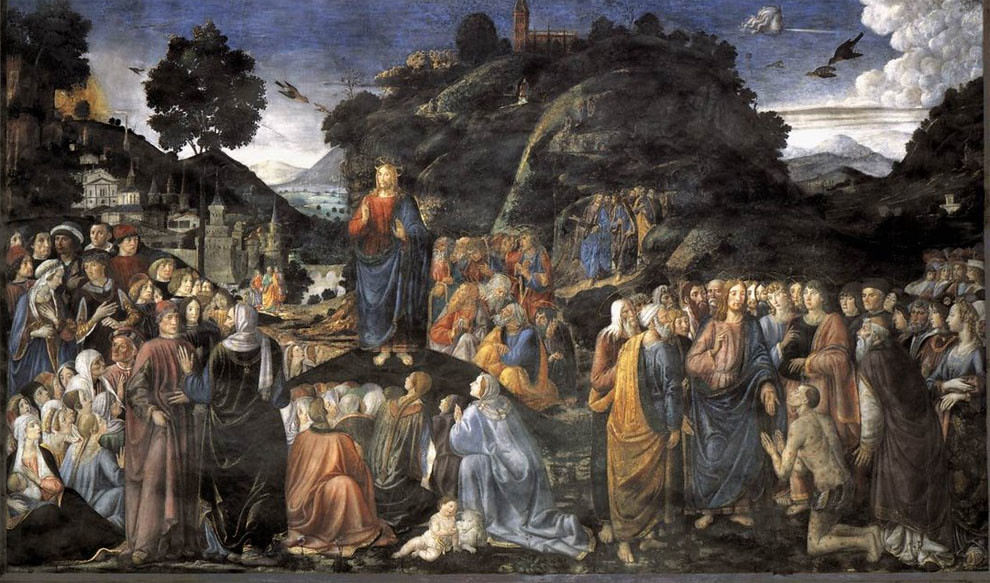
Sistine Chapel Northern Wall-Sermon on the Mount (Cosimo Rosselli, 1481-1482).
In the Sermon on the Mount Jesus handed out the rules that would become the Christian guidelines.
To the right another episode is shown: the healing of a leper.
In the Sermon on the Mount Jesus handed out the rules that would become the Christian guidelines.
To the right another episode is shown: the healing of a leper.
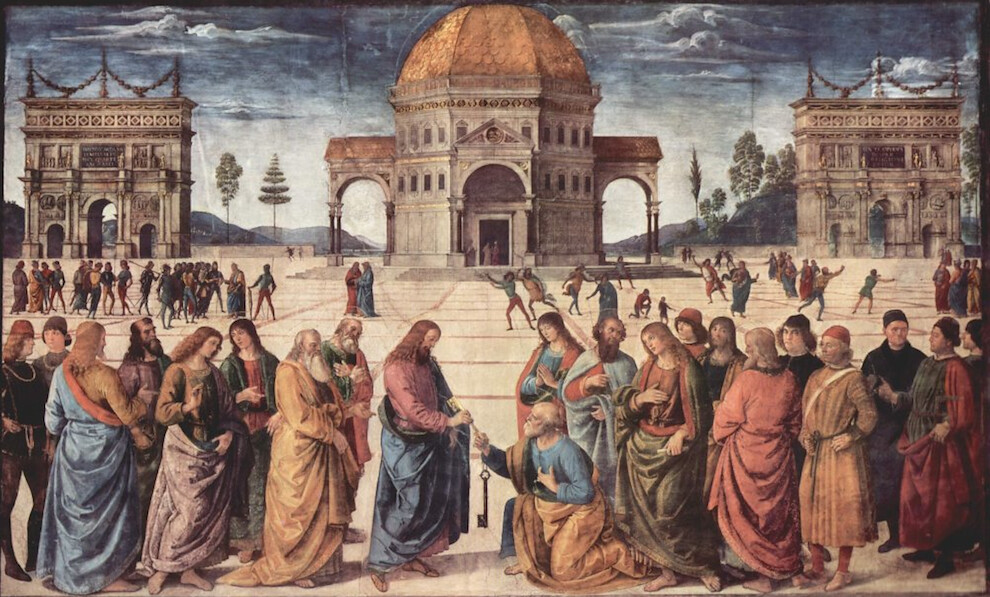
Sistine Chapel Northern Wall-Handing over the keys (Pietro Perugino, 1481 -1482).
Jesus hands the keys of the kingdom of heaven to Peter.
The other followers watch on. They are joined by a few non-biblical figures. Among the men on the right it is thought that Perugino himself can be found alongside the architect of the Sistine Chapel.
In the background two other scenes from the life of Jesus are shown.
To the left: the Rendering of the Tribute Money (ref. Masaccio); to the right: the stoning of Jesus.
Jesus hands the keys of the kingdom of heaven to Peter.
The other followers watch on. They are joined by a few non-biblical figures. Among the men on the right it is thought that Perugino himself can be found alongside the architect of the Sistine Chapel.
In the background two other scenes from the life of Jesus are shown.
To the left: the Rendering of the Tribute Money (ref. Masaccio); to the right: the stoning of Jesus.
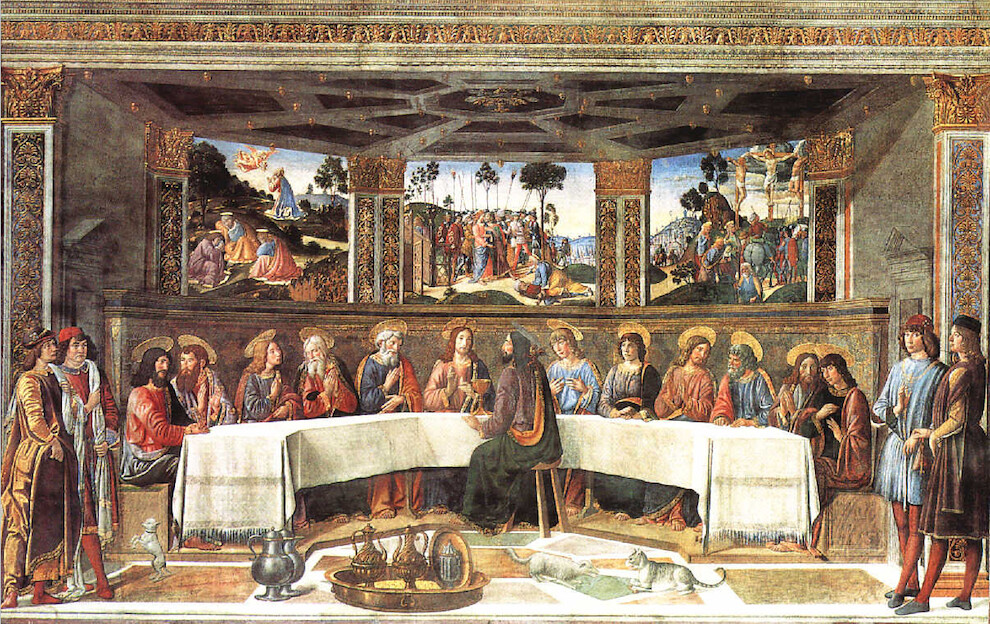
Sistine Chapel Northern Wall – The Last Supper (Cosimo Rosselli, 1481-1482).
Jesus has just shared the bread and the wine. He tells his followers that he will soon die. The apostles seem shocked.
One of the apostles is not surprised. Sitting with his back to the viewer, Judas has a bag over his shoulder. It holds the silver coins he got for betraying Jesus.
The three windows in the background show the events that are about to occur: the prayer on Mount of Olives, the betrayal, and the crucifixion.
Jesus has just shared the bread and the wine. He tells his followers that he will soon die. The apostles seem shocked.
One of the apostles is not surprised. Sitting with his back to the viewer, Judas has a bag over his shoulder. It holds the silver coins he got for betraying Jesus.
The three windows in the background show the events that are about to occur: the prayer on Mount of Olives, the betrayal, and the crucifixion.
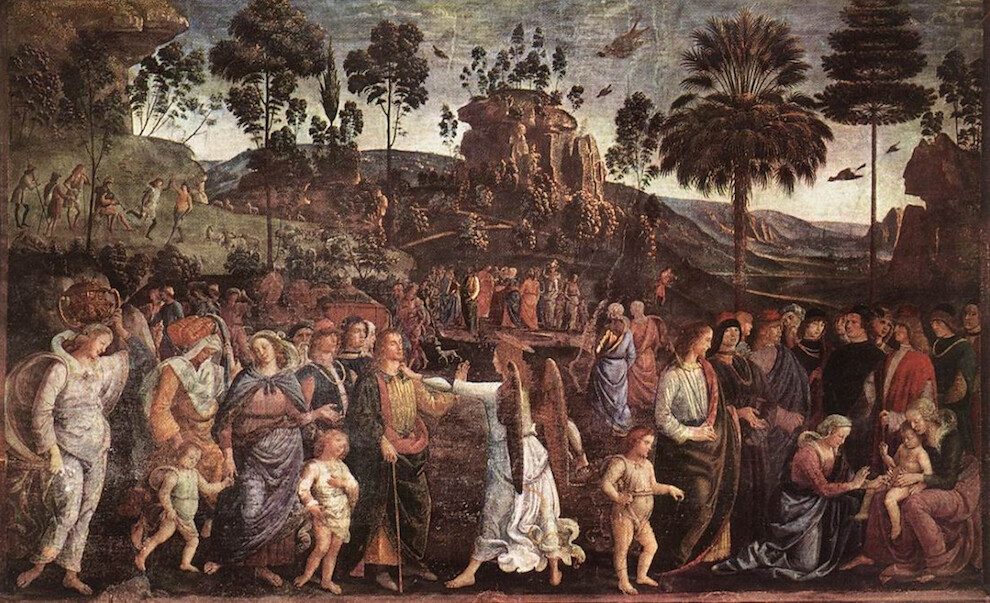
Sistine Chapel Southern Wall – Moses Journey through Egypt. (painted by Pietro Perugino, 1482)
To the right Moses’ son Eliezer is circumsized by his mother Zipporah, a Midianite.
In the center Moses is stopped by an angel, a common depiction of God.
The scenes represent a strange passage in Exodus. Moses is threatened by God. Zipporah then grabs a knife and makes a sacrifice to rescue her husband.
To the right Moses’ son Eliezer is circumsized by his mother Zipporah, a Midianite.
In the center Moses is stopped by an angel, a common depiction of God.
The scenes represent a strange passage in Exodus. Moses is threatened by God. Zipporah then grabs a knife and makes a sacrifice to rescue her husband.

Sistine Chapel Southern Wall – Several scenes out of Moses life. (Painted by Botticelli (Sandro Filipepi), finished 1481-1482)
In the bottom right Moses kills an Egyptian who had attacked a Hebrew (Exodus 2:11-12).
When Pharaoh heard of the murder Moses fled into the land of Midian (Exodus 2:15).
There he drove away a group of shepherds who harassed the daughters of the local priest, Jethro. Moses helped them to water their flock (Exodus 2:17).
He was allowed to marry one of Jethro’s daughters, Zipporah. Moses lived in Midian as a shepherd. The top left shows how one day God appears to Moses in a burning bush (Exodus 3:2).
The ground he stands on is sacred so he has to take off his shoes (Exodus 3:5).
God tells Moses to lead his people from Egypt to the promised land. In the bottom left Moses and his family return to Egypt to perform that task (Exodus 4:20).
In the bottom right Moses kills an Egyptian who had attacked a Hebrew (Exodus 2:11-12).
When Pharaoh heard of the murder Moses fled into the land of Midian (Exodus 2:15).
There he drove away a group of shepherds who harassed the daughters of the local priest, Jethro. Moses helped them to water their flock (Exodus 2:17).
He was allowed to marry one of Jethro’s daughters, Zipporah. Moses lived in Midian as a shepherd. The top left shows how one day God appears to Moses in a burning bush (Exodus 3:2).
The ground he stands on is sacred so he has to take off his shoes (Exodus 3:5).
God tells Moses to lead his people from Egypt to the promised land. In the bottom left Moses and his family return to Egypt to perform that task (Exodus 4:20).
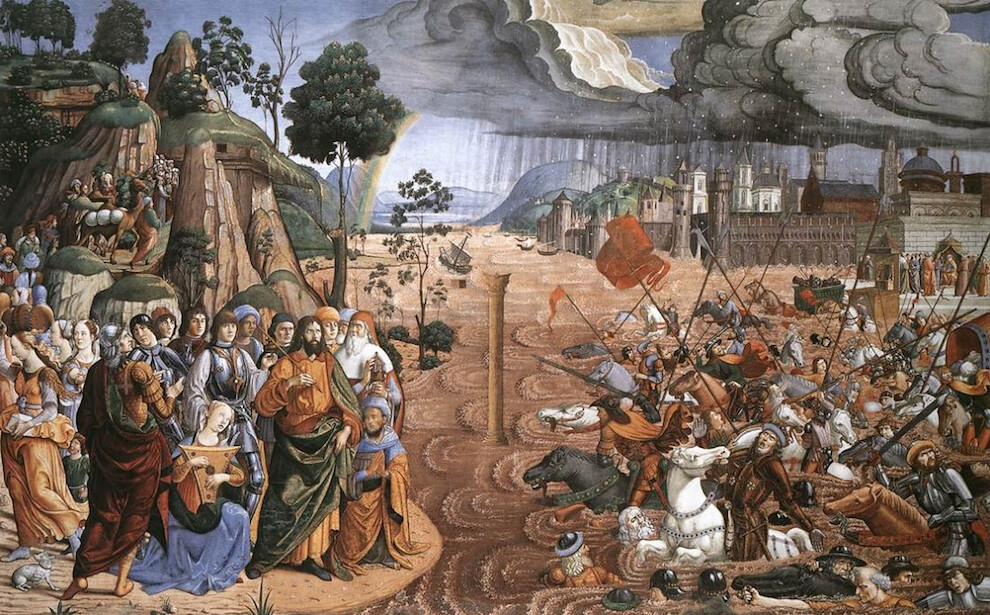
Sistine Chapel Southern Wall – Crossing the Red Sea (painted by Cosimo Rosselli finished 1481-1482).
Moses leads his people through the Reed Sea by parting the waters. He is chased by Egyptian warriors, but the sea closes just in time to save the Israelites. The pillar in the middle is the “pillar of fire” that God used to scare the Egyptians.
Kneeling next to Moses is his sister, the prophetess Miriam.
Moses leads his people through the Reed Sea by parting the waters. He is chased by Egyptian warriors, but the sea closes just in time to save the Israelites. The pillar in the middle is the “pillar of fire” that God used to scare the Egyptians.
Kneeling next to Moses is his sister, the prophetess Miriam.
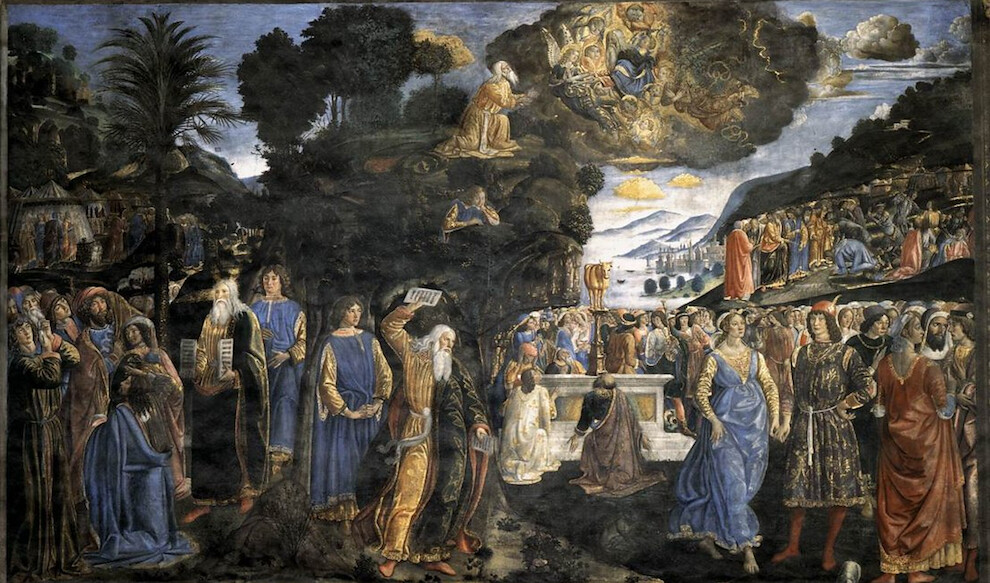
Sistine Chapel Southern Wall – Moses with the Tables of the Law (by Cosimo Rosselli, painted 1481-1482).
Moses receives the tables from God on Mount Sinai. The sleeping youth is Joshua.
To the left on the foreground Moses and Joshua are back and show the tables to the people.
In the center Moses is infuriated when he discovers what has happened in his absence. Spurred on by Moses’ brother Aaron the Jews have made a golden calf that they have worshiped as an idol.
Moses smashes the tables and the worshipers are punished (right).
Moses receives the tables from God on Mount Sinai. The sleeping youth is Joshua.
To the left on the foreground Moses and Joshua are back and show the tables to the people.
In the center Moses is infuriated when he discovers what has happened in his absence. Spurred on by Moses’ brother Aaron the Jews have made a golden calf that they have worshiped as an idol.
Moses smashes the tables and the worshipers are punished (right).
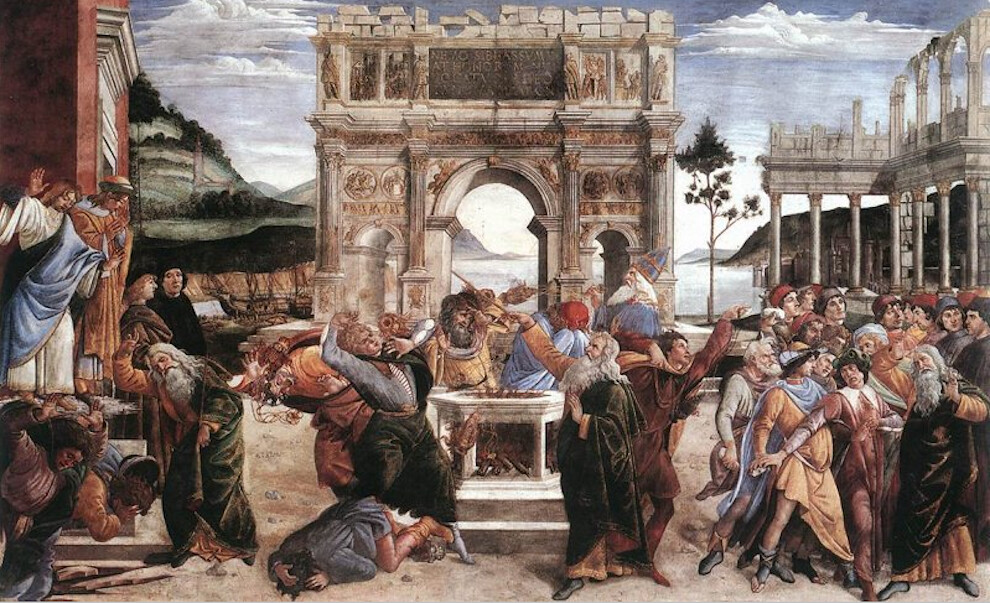
Sistine Chapel Southern Wall – the Punishment of Korah, Dathan, and Abiram (Botticelli (Sandro Filipepi), 1482).
On the right, Joshua stops rebels ready to stone Moses.
In the center, Aaron (with miter) is attacked by people who dispute his priesthood.
On the left, Moses calls on God to punish the rebels.
The arch in the back is the Arch of Constantine, built near the Coliseum in Rome.
On the right, Joshua stops rebels ready to stone Moses.
In the center, Aaron (with miter) is attacked by people who dispute his priesthood.
On the left, Moses calls on God to punish the rebels.
The arch in the back is the Arch of Constantine, built near the Coliseum in Rome.
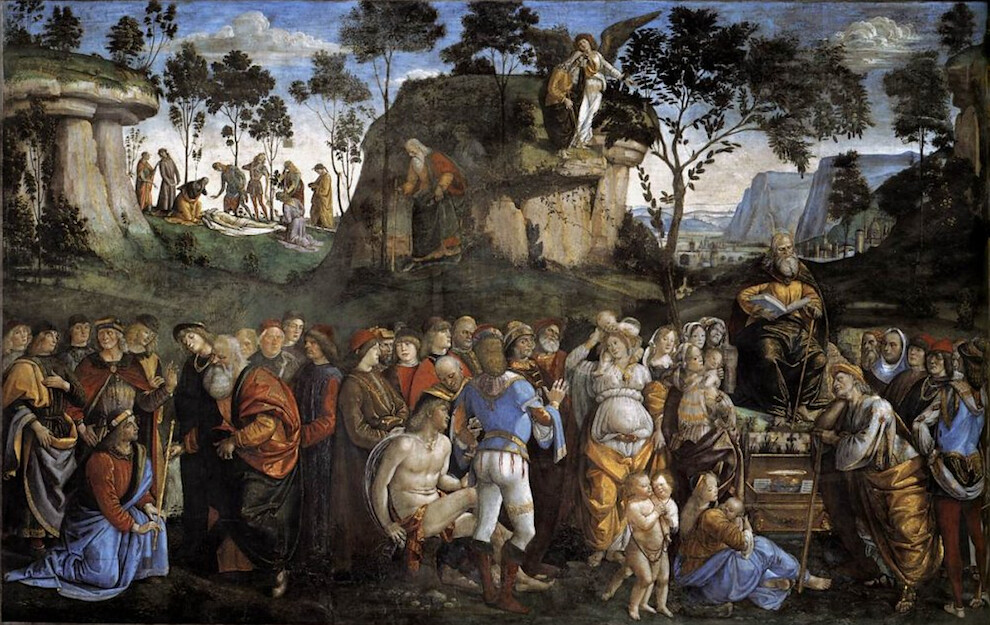
Sistine Chapel Southern Wall – Moses’ last acts and death (Luca Signorelli, 1481-1482).
On the right Moses reads to a listening crowd (Deut. 29-30).
At his feet is the Ark of the Covenant, with the two tables of the Law.
On the left he hands over his leadership to his succcessor Joshua.
In the center of the background Moses is on Mount Nebo. An angel shows him the promised land, which he will never reach.
On the left his people mourn his death.
On the right Moses reads to a listening crowd (Deut. 29-30).
At his feet is the Ark of the Covenant, with the two tables of the Law.
On the left he hands over his leadership to his succcessor Joshua.
In the center of the background Moses is on Mount Nebo. An angel shows him the promised land, which he will never reach.
On the left his people mourn his death.


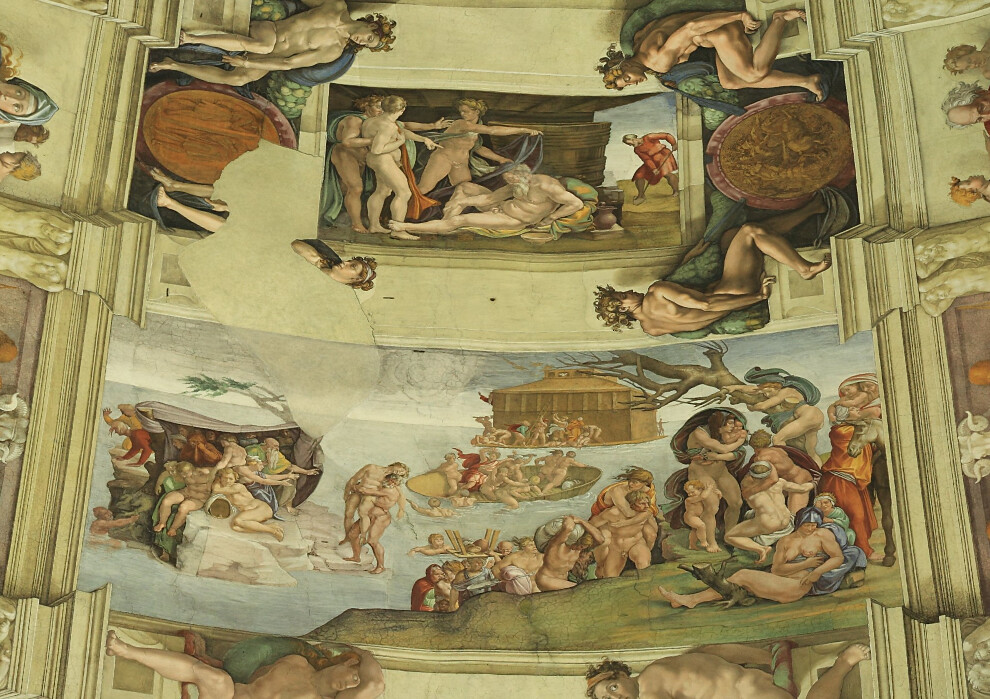
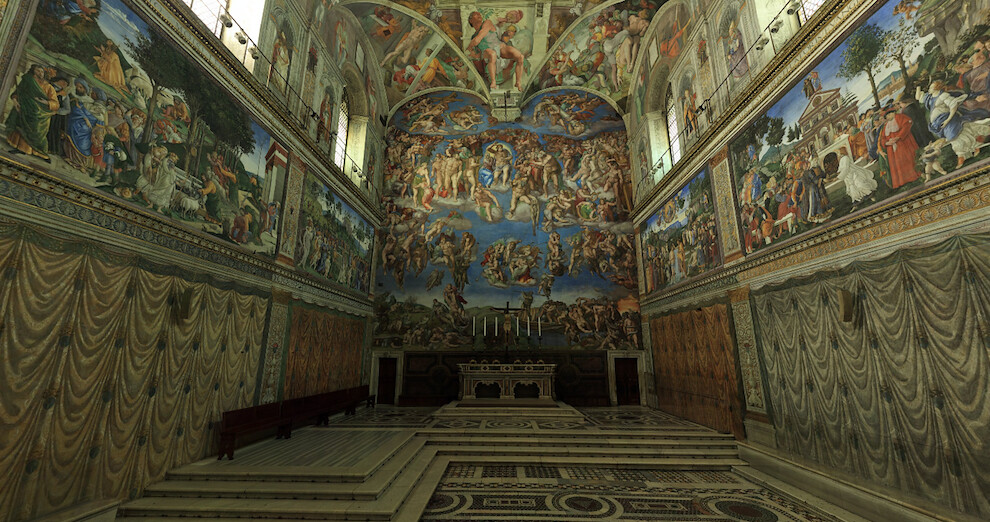
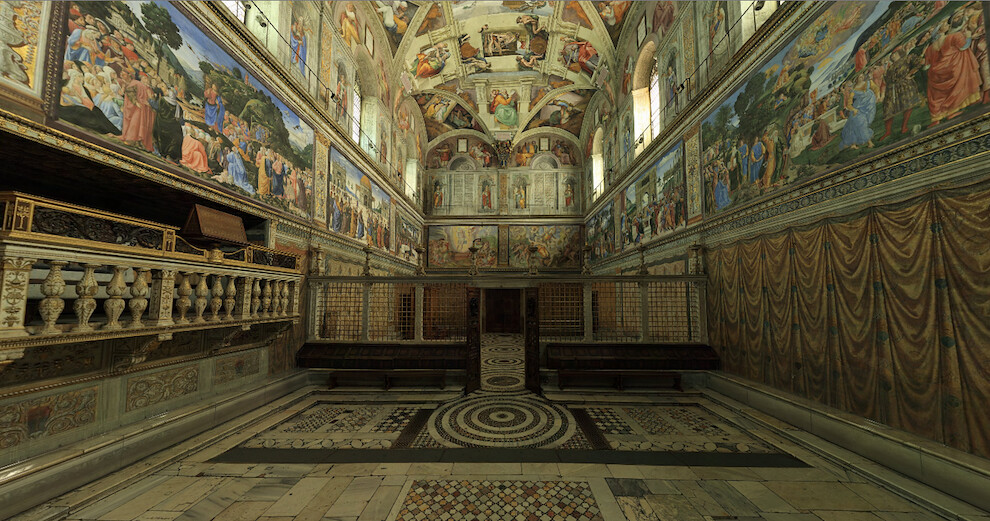
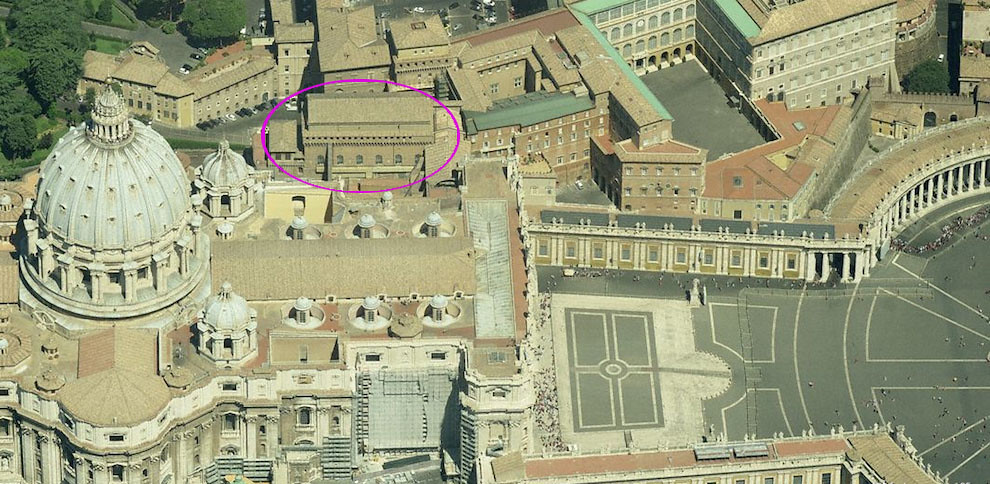
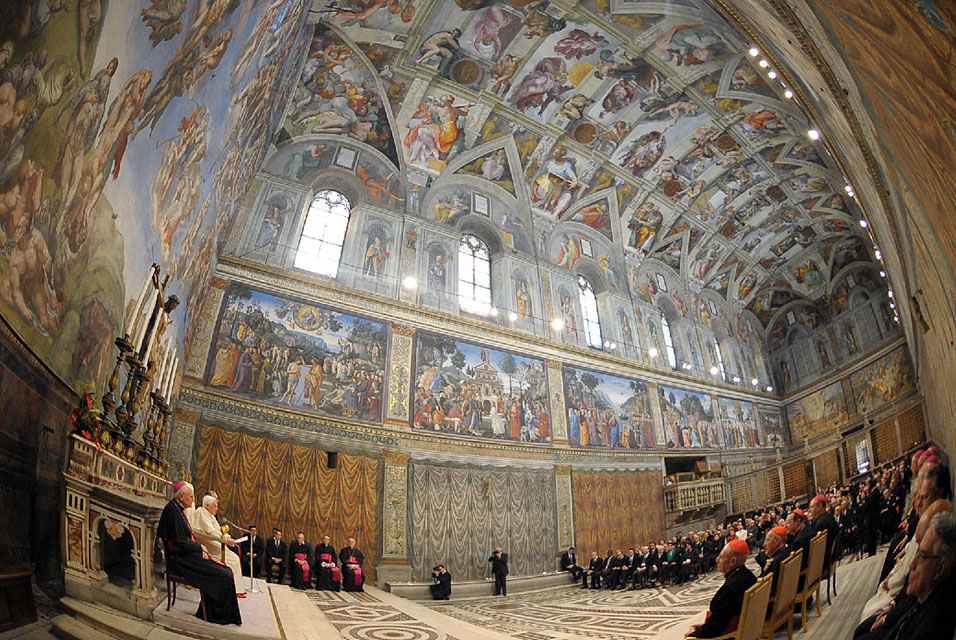
1 comment:
We don't mind you using our article exactly as is but perhaps at least give us a link back on the intro of the article..
We worked hard on this piece. Original here:
http://triggerpit.com/2010/11/21/sistine-chapel-incredible-christian-art-walk-through/
Best regards,
Triggerpit Webmaster
Post a Comment